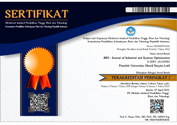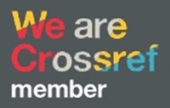ANALISA DAMPAK KECELAKAAN KERJA TERHADAP KERUGIAN FINANSIAL PERUSAHAAN
DOI:
https://doi.org/10.51804/jiso.v5i1.18-25Keywords:
frequency rate, safety rate, safety t score, analysis of real losses and potential lossesAbstract
Penelitian analisa dampak kecelakaan kerja ini bertujuan untuk mengetahui jenis kecelakaan kerja serta dampak kerugian finansial yang dialami PT.X pada tahun 2017 sampai dengan tahun 2019.Data diperoleh dengan menggunakan metode wawancara selanjutnya diolah menggunakan rumus analisa perhitungan Tingkat frekuensi kecelakaan kerja(Frequency Rate), Tingkat keparahan (Safety Rate), Tingkat kecenderungan (Safety T Score), analisa kerugian Real dan kerugian potensial. Diketahui Frequency Rate pada periode 2017 berjumlah 55,88 kali kecelakaan pada periode 2018 mengalami penurunan sebanyak 55,65 kali kecelakaan sedangkan pada tahun 2019 mengalami kenaikan sebesar 78,10 kali kecelakaan setiap sejuta jam kerja. Dari hasil Safety rate periode 2017 berjumlah 8673 jam kerja hilang, pada periode 2018 mengalami penurunan sebesar 4541 jam kerja hilang, sedangkan pada periode 2019 mengalami kenaikan sebesar 6828 jam kerja hilang setiap sejuta jam kerja. Dari hasil analisa perhitungan Safe T Score di peroleh hasil 0,39 yang mempunyai arti pada periode 2017 ke periode 2019 cenderung tidak menunjukkan suatu perubahan, bahwa pada periode 2017 sampai dengan periode 2019 keadaan kecelakaan pada PT.X hampir sama pada tahun-tahun sebelumnya. Setelah melakukan perhitungan kerugian diketahui total kerugian yang di alami oleh PT.X adalah sebanyak Rp.2.283.186.697
ABSTRACT
This work accident impact analysis study aims to determine the type of work accident and the impact of financial losses experienced by PT.X in 2017 to 2019. The data obtained using the interview method is then processed using the calculation formula for the frequency rate of work accidents (Frequency Rate), Severity (Safety Rate), Tendency (Safety T Score), analysis of real losses and potential losses. It is known that the Frequency Rate in the 2017 period amounted to 55.88 accidents, in the 2018 period there was a decrease of 55.65 accidents while in 2019 there was an increase of 78.10 accidents for every million working hours. lost work, in the 2018 period there was a decrease of 4541 lost work hours, while in the 2019 period there was an increase of 6828 lost work hours for every million working hours. From the results of the analysis of the Safe T Score calculation, the results are 0.39, which means that in the 2017 to 2019 period, it tends not to show a change, that in the 2017 to 2019 period, the accident situation at PT.X was almost the same in previous years. After calculating the loss, it is known that the total loss experienced by PT. X is Rp. 2,283,186,697
References
ABDUL BASITH AL KHALIMI, A. B. A. L. K. (2019). Analisis Penentuan Prioritas Penanganan Kecelakaan Kerja Di Laboratorium PT. ABD Dengan Metode Failure Mode And Effect Analysis (FMEA). UNIVERSITAS ISLAM MAJAPAHIT MOJOKERTO.
AFTINIA, N. (2018). ANALISIS EFISIENSI BIAYA PRODUKSI DALAM MENINGKATKAN LABA USAHA TAHU (Pada UD. Pabrik Tahu Langgeng Gamong Kaliwungu Kudus). IAIN KUDUS.
Faqor, N. D. (2018). Analisis Kesehatan Dan Keselamatan Kerja (K3) Bagian Proses Produksi Dan Pengemasan Dengan Metode Hazard And Operability (Hazop)(Studi Kasus Di Cv Cita Nasional Salatiga Jawa Tengah). Universitas Brawijaya.
Firdaus, Y. (2019). Analisis Penggunaan Alat Pelindung Diri pada Proyek Instalasi Rawat Jalan Rumah Sakit Panti Rapih (Analysis Of The Use of Personal Protective Equipment In Outpatient Installation Projects At Panti Rapih Hospital)
Nur, M. (2020). ANALISIS SISTEM KESEHATAN DAN KESELAMATAN KERJA DENGAN METODE ECFA DI. PT XYZ. Industrial Engineering Journal, 9(2).
Nurkholis, N., & Adriansyah, G. (2017). Pengendalian Bahaya Kerja Dengan Metode Job Safety Analysis Pada Penerimaan Afval Lokal Bagian Warehouse Di PT. ST. Teknika: Engineering and Sains Journal, 1(1), 11–16.
Widantoko, B. (2018). Analisis kecelakaan kerja menggunakan pendekatan metode HAZOP serta menghitung kerugian finansial akibat kecelakaan kerja di PT. Sinar Terang Logamjaya.
Downloads
Published
Issue
Section
License
With the receipt of the article by JISO Editorial Board and the decision to be published, the copyright regarding the article will be transferred to JISO. The copyright transfer form can be downloaded here.
JISO has the right to multiply and distribute the article and every author is not allowed to publish the same article that was published in this journal.
JISO is licensed under a Creative Commons Attribution-ShareAlike 4.0 International License.
Under the following terms:
Attribution — You must give appropriate credit, provide a link to the license, and indicate if changes were made. You may do so in any reasonable manner, but not in any way that suggests the licensor endorses you or your use.
ShareAlike — If you remix, transform, or build upon the material, you must distribute your contributions under the same license as the original.














